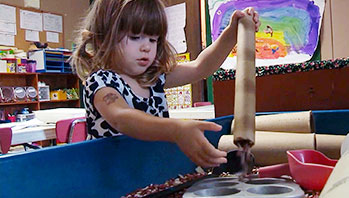- cardboard ramp strips (various heights)
- crayons
- markers
- sand table (or use beans or rice)
- small objects for rolling and sliding (buttons, water bottle caps, pompoms, acorns, connect cubes, etc.)
- three column chart (roll/slide/roll and slide)
- ramp
- roll
- slide
MA Standards:
English Language Arts/Speaking and Listening/SL.PK.MA.1: Participate in collaborative conversations with diverse partners during daily routines and play.
MA Draft STE Standards:
Physical Sciences/Motion and Stability; Forces and Interaction/PS2.A: Plan and carry out investigations of the behaviors of moving things.
Head Start Outcomes:
Approaches to Learning/Initiative and Curiosity: Demonstrates flexibility, imagination, and inventiveness in approaching tasks and activities.
Approaches to Learning/Cooperation: Plans, initiates, and completes learning activities with peers.
Logic and Reasoning/Reasoning and Problem Solving: Classifies, compares, and contrasts objects, events, and experiences.
Science Knowledge/Scientific Skills and Method: Uses senses and tools, including technology, to gather information, investigate materials, and observe processes and relationships.
PreK Learning Guidelines:
Science and Technology/Physical Sciences 21: Explore and describe various actions that can change an object’s motion such as pulling, pushing, twisting, rolling, and throwing.
Science and Technology/Technology and Engineering 23: Explore and describe a wide variety of natural and man-made materials through sensory experiences.
Roll, Slide, or Both

© Commonwealth of Massachusetts, Department of Early Education and Care. All rights reserved.
Skill Focus: Listening and Speaking, Small Motor Skills, Vocabulary
Fill the sand table with any material you decide. Set up a few ramps of different steepness on one end of the sand table. Before the activity, hide small items, such as marker caps, cubes, pompoms, etc., in the sand or beans.
- Tell children they will be hunting for items that roll, slide, or roll and slide and then recording those items on the chart.
- Have children take turns feeling around and hunting for objects in the sand. Once they find an object ask them to describe how they think it will move down the ramp. Encourage them to try moving the object on different ramps and discuss the outcomes.
- Have each child draw his or her object in the column of the chart that shows how it moves. (it rolls, it slides, or it rolls and slides)
Adaptation: Family-based childcare educators and smaller group-based environments may not have room for a sand table. You can adapt this activity by using a large plastic box for the sand and hunting objects, and a second plastic box to set up the ramps. Place the two boxes side by side so children can work in one area. Use boxes with lids to keep them contained and easy to pull out another day.
